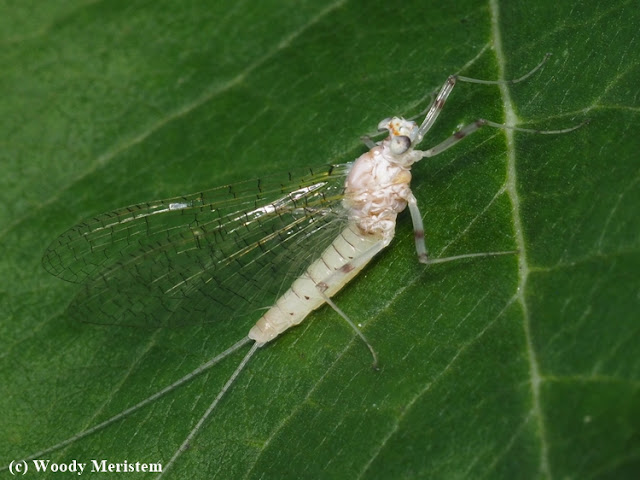May flies, as do all the other months as you get older – but that’s not the subject for today. Today we’re talking about mayflies (known as fishflies in Canada and some adjacent U.S. states), those very primitive insects that live in streams as nymphs and whose adults don’t feed and live but a short time.
There are at least 3,000 species worldwide with a variety of lifestyles, although there are many similarities. The nymphs live in clean unpolluted water, usually in streams but some species live in lakes, where they feed on fallen leaves or algae – although a few are predators. The nymphs live on the bottom, often beneath rocks or logs, some species live there for months and others for years.
Any one species’ nymphs all rise to the surface over a short time, often only an hour or two, and molt into their winged stage – in what fishermen call a “hatch”. The newly molted adults mate, the females lay their fertilized eggs, and all die – often within a day or two. Adults emerge not just in May, but throughout the warmer months.
Mayflies are beloved by trout and those who fish for trout. Beloved by trout as food and by those who fish for trout because mayflies emerging from the water can be imitated by artificial lures.
Mayflies come in a wide variety of sizes and colors, many are beautiful and worthy of a close look –
Next time you’re near an unpolluted stream, river or lake, early or late on a warm day, take a look around and you may see a mayfly or perhaps a “hatch” of thousands.
.JPG)
.JPG)
.JPG)
.JPG)
.JPG)
.JPG)
.JPG)
.JPG)
.JPG)
.JPG)
.JPG)


Oh how timely! I just sent the link to M; he's out in Idaho trout fishing as I write. And yes he's been fly tying and experimenting and sometimes even matching the hatch correctly and catching and releasing a beautiful rainbow or brown. But Silver Creek Preserve is tricky and its trout are very wise and elusive. All the miore a challenge. Thank, Woody, for the upclose images. Inspiration for that tyer I would think. Kim in PA
ReplyDeleteBeautiful captures and interesting information!
ReplyDeleteThese are all so neat and very hard to photograph. We've had so many dragonflies and mayflies this summer....but then, we've had a lot of bugs and insects for them to feast on!
ReplyDeleteLove this. I have brooks on my land and get mayflies every year. But none look like yours here. Like most wild things in Vermont, they are "drab." And smallish. But if I go to the lake during a hatch, they are a totally different species. I love the one with the pure white head.
ReplyDelete